

 The South African
The South African
This medal group is of particular interest as Green was one of only three officers, and the last man of a group of 143 officers and men, to leave the trenches at Delville Wood on the final day - 20 July 1916 - of this epic in South African military history. The medal group includes the first of only 14 awards of a Military Cross and Bar to a South African during the Great War. Green was killed later in the war in the great German Offensive of March 1918.
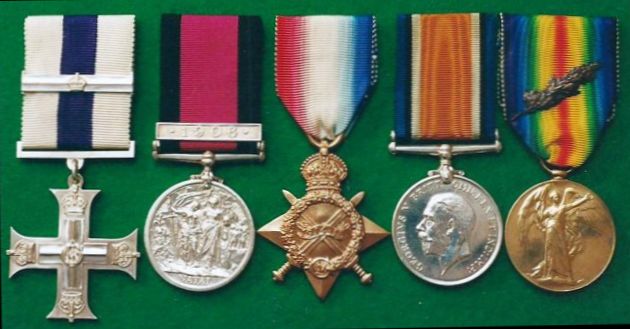
His medals are shown in colour on the back cover of the Journal.
From left to right
Green was born at Dundee in 1889 and educated at the local secondary school. His name appears on both the Dundee school and town war memorials, and on the war memorial in the gardens below the Union Buildings in Pretoria. He was unmarried and employed at the Native Affairs Department in Pretoria at the time of his enlistment in the Great War.
He had previously served as a Trooper in the Natal Carbineers 21 August 1905 to 12 November 1911. During this period he participated in the campaign against Bambata in Natal on three occasions: 9 February 1906 to 31 March 1906, then 18 April 1906 to 2 August 1906 and finally 1 November 1907 to 24 December1907.
Green then re-enlisted as a Trooper with the 1st Mounted Rifles (Natal Carbineers) on 25 August 1914 and served in General Botha's campaign in the conquest of German South West Africa from October 1914 to May 1915. He was present at the most significant battle of this campaign which took place at Gibeon on 27 April 1915. Gibeon now appears on the regimental colour of the Natal Carbineers amongst its proud record of 26 Battle Honours. The Natal Carbineers are the senior regiment in South Africa.
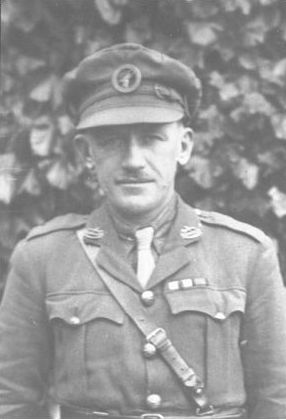
Garnet George Green
Discharged on 23 July 1915, he re-enlisted once again on 1 September 1915 as a Lance Corporal in B Company of 2nd S.A. Infantry battalion of the S.A. Overseas Expeditionary Force for service in Egypt, France and Belgium.
After training at Potchefstroom, the 1st S.A. Brigade went to England for further training, and then saw their first action against the Senussi in Egypt between January and March 1916. Green received his commission on 16 May 1916.
He was wounded on 18 July 1916 on the fourth day of the battle of Delville Wood whilst in command of C Company of the 2nd S.A. Infantry. This was the day of greatest losses to the South Africans, in total 260 killed and missing, and this excludes those died of wounds and wounded. Of this number, the 2nd S.A. Infantry losses were 82. After Delville Wood medical treatment was to keep Green out of action until 8 September 1916.
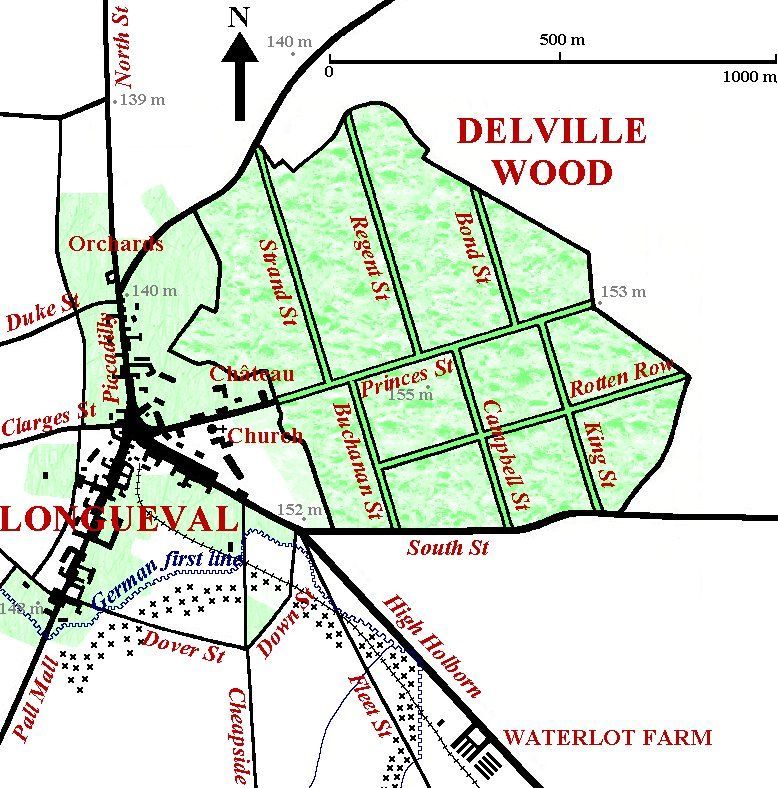
Map of Delville Wood
When the surviving three wounded
officers and 140 men were finally relieved
at 6 p.m. on 20 July 1916, the sixth day of
the battle, Green was one of these three.
Ian Uys in his book "Rollcall" states:
"Lieutenant Colonel Thackeray and
Lieutenant Phillips led the exhausted
survivors south out of the wood. Second
Lieutenant Green brought up the rear, the
last South African to leave the wood."
Of this group of survivors, 2nd
Lieutenant Phillips and 59 other ranks of
the Trench Mortar Battery had only been
sent in as reinforcements on 18 July.
Thackeray, Green and 81 other ranks are
thus the only men to have endured the full
six days of the fighting in Delville Wood. For
his gallantry at Delville Wood, Green was
awarded the Military Cross in the London
Gazette 1 January 1917. The full recommendation
dated 3 October 1916 signed by
Lieutenant Colonel Tanner of the 2nd S.A.
Infantry, reads:
"This officer was sent to the Front Line
at Delville Wood to take over C Company of
the 2nd South African Regiment after all the
officers of this company had been killed or
wounded. He behaved with great gallantry
and coolness under heavy fire, and by his
example put fresh energy and confidence
into the remaining men. He kept up
communication with Colonel Thackeray
who was in command at the time, and
moved with his men to support Colonel
Thackeray in Buchanan Street Trench,
holding a portion of this and attacking and
dispersing a body of Germans who were
endeavouring to dig in about 30 yards
away. HE WAS THE LAST TO LEAVE
THE TRENCH WHEN RELIEF ARRIVED
(author’s capitals) and throughout
behaved in a fearless and gallant manner
instilling energy and confidence into his
men. His conduct on all occasions was
exemplary."
In all, there were 106 recommendations for awards to officers and men for this battle. Only 62 awards were granted, which represents 1.5 awards per 100 men involved. The number of participants recorded by name in the book Roll Call by Ian Uys is over 4 000. There were four recommendations for the award of the Victoria Cross but only one was granted, to Pte. W.F. Faulds of 1st S.A. Infantry. Ironically, the Royal Welsh Fusiliers who were part of the relieving force on 20 July 1916 won two Victoria Crosses on that single day. Maybe the British had a different approach to awarding the Victoria Cross to the Colonials as opposed to their own soldiers. Thackeray was denied a Victoria Cross and was admitted a Companion of the Distinguished Service Order instead. His father had won the Victoria Cross in the Indian Mutiny, and this could have then been only the fourth instance of father and son earning the Victoria Cross. The father's medal group is in the Ditsong (formerly S A) National Museum of Military History in Johannesburg.
In General Lukin's dispatch, Green is
the only officer with three other ranks of
the 2nd S.A. Infantry specifically
mentioned. Lukin says this of Green:
"Returning to the trenches after being
wounded and devotion to duty. July 18-20th.”
In the last paragraph Lukin makes the point that it has been impossible to obtain all recommendations of regimental officers because of the heavy casualties. This was particularly so as regards the 2nd S.A. Infantry, as all officers had become casualties.
There were 121 officers and 3032 men of the 1st S.A. Brigade as counted on midnight 14 July. Of the 4 000 officers and men who actually served in Delville Wood, only 5 officers and 750 men paraded before Brigadier-General Tim Lukin on 21 July. 763 had been killed in action, died of wounds, or assumed dead, and 1476 wounded and 297 were made POW's.
Promotion
Green was promoted Temporary Lieutenant in October 1916. He was awarded a Bar to his Military Cross in the London Gazette 24 July 1917. The recommendation dated 20 April 1917 was for the award of a D.S.O. He was the first of the fourteen South Africans to be awarded a Bar to his M.C. in the war.
"For conspicuous gallantry during the afternoon of the 12th April 1917, when in order to obtain definite information regarding the result of our attack East of Fampoux he voluntarily reconnoitered the ground under heavy machine gun fire and returned with the position clearly shown on his map, and thus cleared up a situation which up to this time was unknown".
The casualties of the three battalions of the S.A. Brigade involved on that day numbered 712.
Green was promoted Captain in January 1918. Early in 1918 the S.A. Brigade was again in the area of Delville Wood and took the opportunity of holding a Memorial Service on that hallowed ground on 17 February 1918. At this service gallantry medal ribbons were presented to 40 officers and men. Green's Bar to his M.C. was the highest award recognized on that day.

Of the 40 recipients of decorations that day, 11 men were recorded by Ian Uys as present at the battle of Delville Wood in 1916. One can only reflect on what their thoughts were when receiving the ribbons to their decorations.
In the great German Offensive of 1918 the British 5th Army was beaten back over vast areas of the former battlefields of the Somme. In sixteen days between 21st March and 5th April 1918 the Germans advanced the front line by 65 kms from St Quentin almost to Amiens, way past the entire area of the Battle of the Somme shown in green in the map. In the Battle of the Somme from 1 July to 18 November 1916 in 141 days the British had only advanced the front line by 10 kms.
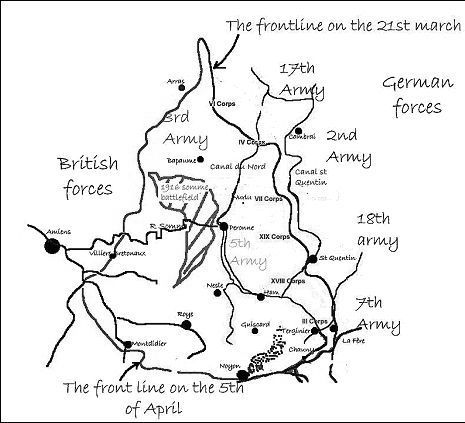
Area of German offensive in March - April 1918
Green commanded B Company of 2nd S.A. Infantry in a rearguard action at Gauche Wood on 22 March 1918. His stubborn resistance held up the Germans at a critical time. Green was killed and his company destroyed. His name was mentioned in the Union Parliament on 28 Match 1918 by the Prime Minister General Botha in a long speech in which he said:
"It was at Gauchemont the other day, where the battle was raging with full fury and Captain Green and his 120 men were in the midst of it, and the report which we have received shows that those 120 men for 24 hours held up three German divisions. The bravery displayed by those men was grand - it was a bravery which was even greater than that displayed in the immortal Delville Wood battle"
There surely cannot be many officers of the low rank of Captain who have had their names mentioned in Parliament by his Prime Minister and Commander-in-Chief of the Army.
In the records of the Commonwealth War Graves Commission, Green has no known grave. His name appears with those of 321 South Africans amongst the 14 695 names on the Pozieres Memorial to those without known graves who fell during the Fifth Army retreat on the Somme from 21 March to 7 August 1918.
However the Roll of Honour lists only three South African Captains killed in 1918 with no known graves, and two of these were on 23 March 1918 at Gauche Wood. One was Green, the other Captain Max Saphir of 4th S.A. Infantry from Durban, born in Russia. I would like to believe this is Green’s grave.
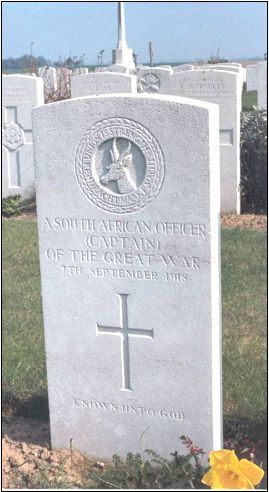
This photograph, taken by Ian Uys, is
the grave of an unknown South African Captain
buried in the Gouzeaucourt Military
cemetery very close to Gauche Wood.
The headstone inscription is
"A South African officer (Captain) of the
Great War - 7th September 1918".
The British 5th Army was beaten back over vast areas of the former battlefields of the Somme. It was only on 8 August 1918 that the advance began and the British again took possession of the area around Gauche Wood. The Germans must have found a body identified as a South African Captain by badges, and buried him. The date given on the headstone thus being after the British repossessed the area and discovered the grave.
Letters of condolence to Green's
brother from the Mayor of Pretoria and
from Colonel Christian, who commanded
the 2nd S.A. Infantry in 1918, have
survived. The Colonel describes at
length the action of Green's company,
and ends by saying:
"Your brother was the best officer
we ever had in the regiment and if he
had only lived he would have gone far.
I am very proud to say that he was a
great personal friend of mine"
A few days later on 25 March 1918, the S.A. Brigade, which numbered only 500, fought at Marrières Wood until all ammunition was expended, and having suffered 400 casualties, the remaining 100 were taken prisoner.
His name is mentioned in the following books:
General Lukin's dispatch after Delville
Wood
Recommendation for the award of the
M.C. dated 3.10.1916
Soldier's service papers from Defence
Headquarters at Pretoria
Correspondence with the Regimental
Historian of the Natal Carbineers
Four pages of Brigade Orders for the
Memorial Service at Delville Wood 1917
First 2 pages of a report on Gauche Wood,
with Green specifically mentioned
War Diary of 2nd S.A. Infantry 24 May
1917, recording the Bar award to
Green's M.C.
War Diary of the Brigade 20 July 1916
where Green is named as one of the
three surviving officers
Colonel Tanner’s report dated 20 April
1917 after Fampoux, wherein Green's
action for the Bar M.C is specifically
mentioned.
Where are the medals of the only other two officers with Green when the 143 were relieved on the last day of the battle?
Col. Thackeray's group of 12 was sold in London at Bonhams on 25.9.2007 for 2000 pounds, and is now in a Johannesburg collection. Lt. Phillips single Military Cross, inscribed with his name by his family, was sold by Kaplan Auctioneers in Johannesburg to Ian Uys. Phillips was from East London, and was killed in October 1916. Garnet Green's medals have taken pride of place in the author's collection for well over 30 years.
Green's sister's husband Samuel Henry Richardson, 34, was an officer on the Mendi and died on 21 February 1917 when the vessel sank in the English Channel with the loss 616 South African troops, nearly all black men.
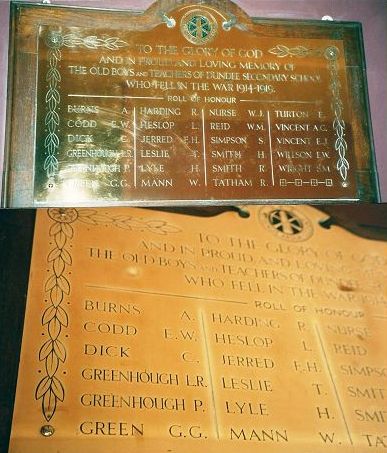
Roll of Honour at the Dundee Secondary School
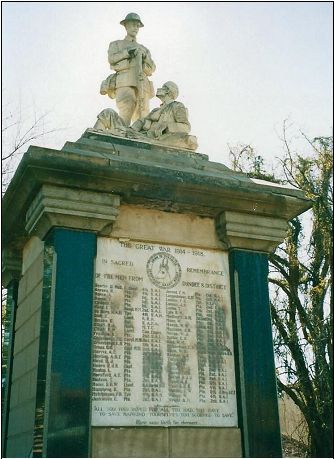
Cenotaph in the Dundee Town centre
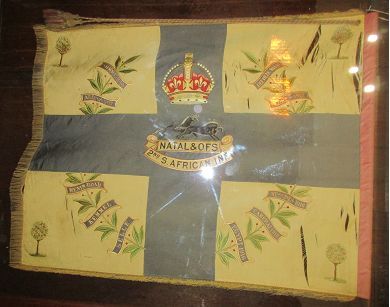
Regimental Colour of the 2nd South African Infantry with the ten Battle Honours selected from the fourteen gained for France and Flanders, plus Egypt 1916. This Colour is on display in the Anglo-Boer War Museum in Bloemfontein.
The Battle Honours in bold are the ones appearing on the Regimental Colour.
Garnet George Green would have been involved in all the above mentioned battles in 1916 and 1917. He was killed on 23 March 1918 so was not involved in any of the 1918 battle honours. He was out of action when he was granted ten days leave 13 -25 November 1916, and when he was hospitalised with enteric fever from 3 May to 26 June 1917.
Return to Journal Index OR Society's Home page
South African Military History Society / scribe@samilitaryhistory.org